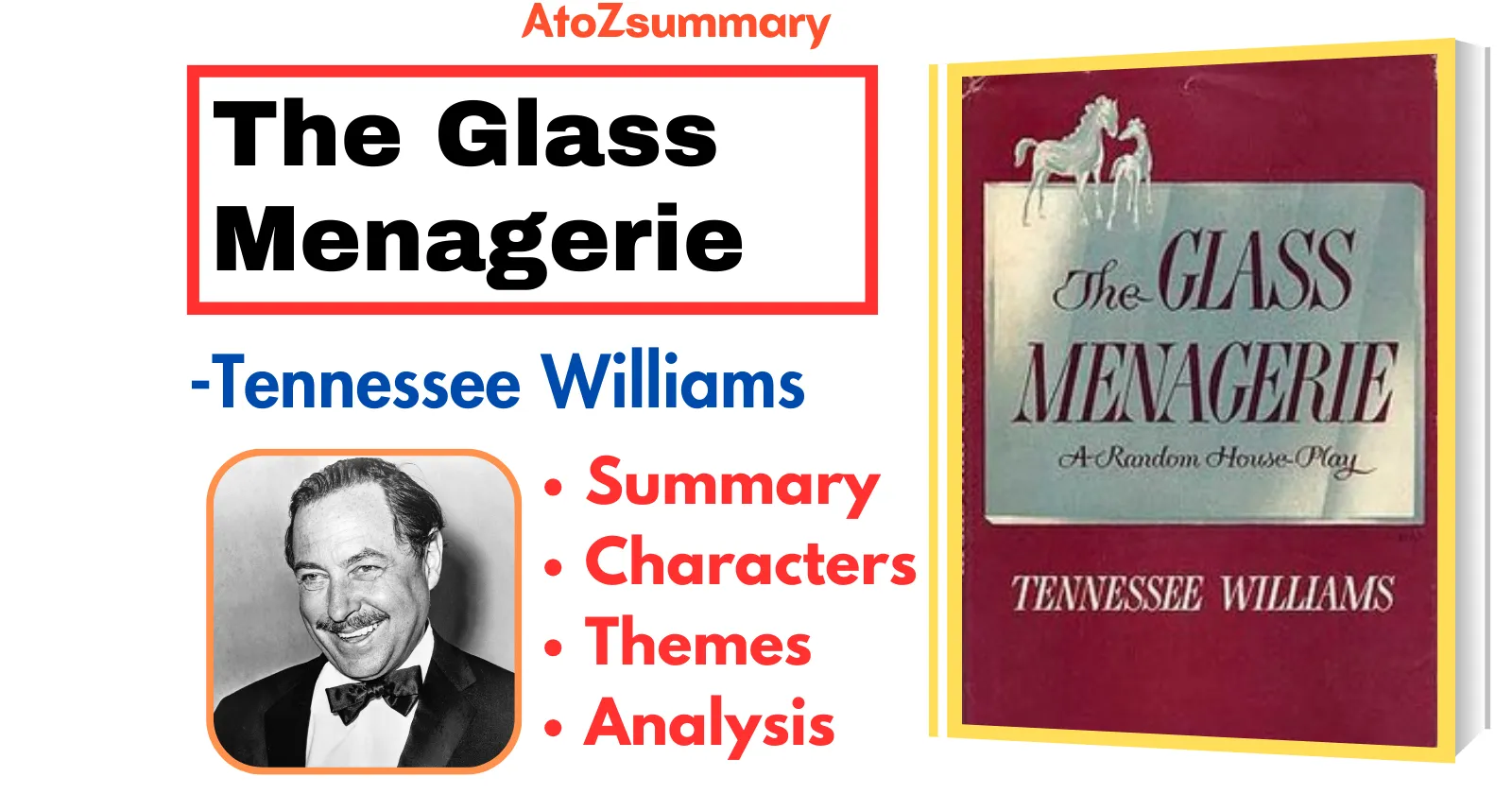About the Play: The Glass Menagerie
| Title | The Glass Menagerie |
| Auhtor | Tennessee Williams |
| Genre | Memory Play, Drama |
| Setting | St. Louis, 1930s |
| Structure | Four Acts |
| Tone | Reflective, Poetic, Melancholic |
| Symbols | – Glass Menagerie (Laura’s collection) – The Fire Escape |
Analysis: The Glass Menagerie
Tennessee Williams’ play “The Glass Menagerie” explores the lives of the Wingfield family. The plot revolves around the mother, Amanda, and her two adult children, Tom and Laura. Amanda is desperate to find a suitor for Laura, who is shy and introverted, and she pressures Tom to bring her a friend. Tom, on the other hand, is dissatisfied with his life and wishes to pursue his own ambitions.
The play is known for its symbolism, especially the glass menagerie that Laura cares for. The fragile figurines represent the delicate nature of the family’s dreams and the illusions they create to cope with their difficult reality.
Characters: The Glass Menagerie
The characters of “The Glass Menagerie” by Tennessee Williams are:
- Amanda Wingfield: The mother, who is determined to find a suitor for her daughter and wants the best for her family.
- Tom Wingfield: The son and narrator, who works in a shoe warehouse but dreams of a more adventurous life.
- Laura Wingfield: Tom’s sister, who is shy, fragile, and spends much of her time with her glass animal collection.
- Jim O’Connor: A gentleman caller who Tom brings home for Laura in the hope of a romantic connection.
Themes: The Glass Menagerie
The themes of “The Glass Menagerie” by Tennessee Williams are:
- Escape: The characters want to escape their difficult realities and pursue their dreams.
- Illusion vs. Reality: The play explores the contrast between the characters’ illusions and the harsh realities they face.
- Family Dynamics: The strained relationships within the Wingfield family are a central theme, highlighting the challenges and complexities of family life.
- Memory: The characters grapple with memories of the past, affecting their present actions and perceptions.
- Isolation: Each character experiences a sense of isolation, both physically and emotionally, contributing to their struggles.
- Fragility of Dreams: The play delves into the delicate nature of dreams and how easily they can be shattered or distorted.
- Symbolism of the Glass Menagerie: The glass animals symbolize the fragility of the characters and their dreams, serving as a metaphor for their vulnerabilities.
Watch Full Play Summary Video of “The Glass Menagerie”
The Glass Menagerie Summary
As a memory drama, The Glass Menagerie takes place in the narrator Tom Wingfield’s recollections. The drama is about a character named Tom, and it takes place in 1937 in St. Louis. He works long hours in a shoe warehouse as an aspiring poet to provide for his sister Laura and mother Amanda. Tom and Laura’s father, Mr. Wingfield, fled away years ago and hasn’t been heard from since—aside from one postcard.
Originating from a refined Southern background, Amanda often regales her kids with stories of her carefree childhood and the several suitors who once had her on their hands. She is dismayed that painfully timid Laura, with a brace on her leg, is not drawing any masculine callers. In the hopes that Laura would use a business profession to create both the family’s and her wealth, she enrolls in a business college. However, Amanda finds out weeks later that Laura has discreetly dropped out of the class and is spending her days alone traveling the city due to her debilitating shyness. After concluding that marriage is Laura’s last chance, Amanda starts reselling magazine subscriptions to supplement her income and maybe attract more suitors for Laura.
To his mother’s dismay, Tom, who despises his warehouse work, escapes into alcohol, movies, and books. Tom unintentionally shatters several of Laura’s most valuable glass animal sculptures during one of their many confrontations as mother and son.
After talking about Laura’s possibilities, Amanda asks Tom to watch the warehouse for possible suitors. Tom chooses his casual buddy Jim O’Connor and extends an invitation to supper. When Amanda questions Tom about Jim, she is happy to discover that he is a motivated young man who is focused on advancing his profession. She makes a fancy meal and has Laura change into a new outfit. Laura finds out at the last minute who her caller is, and it turns out that she has a serious high school crush on Jim.
Jim comes, and Laura answers the door per Amanda’s instructions before hurriedly vanishing and leaving Tom and Jim alone themselves. Tom tells Jim that he intends to quit his work and his family in pursuit of excitement, having diverted the money meant for his family’s electricity payment to enlist in the merchant marines. Laura pretends to be unwell to avoid eating supper with the others. Amanda interacts animatedly with Jim during lunch while sporting an elaborate attire from her glitzy childhood.
Just as supper is about to conclude, the overdue electricity bill causes the lights to go off. Candles are lit by the people, and Amanda suggests that Jim amuse Laura in the living room while she & Tom tidy up. Jim’s presence first paralyzes Laura, but she eventually comes out of her shell thanks to his kind and approachable demeanor. She acknowledges that when in high school, she knew and liked him, but she was too hesitant to talk to him. As they converse more, Laura brings up the moniker he had given her: “Blue Roses,” which was an unintentional perversion of pleurosis, a condition she suffered from throughout her high school years. He calls her out on her timidity and poor self-esteem while highlighting her individuality.
Laura then takes the risk of showing him her unicorn, a treasured glass creature. While dancing with her, Jim unintentionally topples the unicorn and snaps off its horn. Laura is understanding, pointing out that the unicorn is now a typical horse. After that, Jim kisses her, but he soon retracts and says he’s sorry, saying he got swept away by the excitement and that he has a real girlfriend. Laura, giving up, hands him the shattered unicorn as a memento.
Glancing across the living area, Amanda is beaming. Jim quickly clarifies that he needs to go since he has to meet his fiancée. Amanda bids him farewell with warmth, but not before she turns on Tom, who is unaware that Jim is engaged. After accusing Tom of being a careless, conceited dreamer, Amanda rushes to Laura’s side to offer her comfort. Tom observes the two ladies from their apartment’s fire escape and tells them that he is fired from his job shortly after Jim visits and leaves Amanda and Laura behind.
In the end, Tom leaves his family to pursue his own dreams and escape the stifling environment at home. He feels guilty for leaving but believes it’s necessary for his own happiness. Amanda and Laura are left to face their own challenges, and the play concludes with a sense of unresolved tension and the impact of Tom’s departure on the Wingfield family.
FAQs
What is the glass menagerie story about?
It’s about a family’s struggles and dreams in the Great Depression.
Why was The Glass Menagerie so popular?
The Glass Menagerie was popular for its relatable characters, poignant themes, and innovative theatrical style.
What does the glass unicorn symbolize?
The glass unicorn symbolizes Laura’s uniqueness, fragility, and shattered dreams.
What does Amanda give Laura to make her more attractive?
Amanda gives Laura a little padding to make her bosom fuller.
What is Laura’s disability in The Glass Menagerie?
Laura has a slight limp due to a childhood illness.
Why was Laura crying in The Glass Menagerie?
Laura was crying because she felt trapped and alone in her own world.
Why does Tom smoke in The Glass Menagerie?
Tom smokes in The Glass Menagerie to escape the frustration and boredom of his life.
Why is Amanda so upset with Tom at the end of the play?
Amanda is upset with Tom because he abandons her and Laura to pursue his own dreams.
Does Tom love Laura in glass menagerie?
Tom’s relationship with Laura is complex and multifaceted, but it is ultimately one of deep love and protectiveness.
What secret does Tom reveal to Jim The Glass Menagerie?
Tom reveals to Jim that he has joined the Merchant Seaman’s Union and plans to leave St. Louis to escape his mundane life.
Is The Glass Menagerie Based on a true story?
Yes, The Glass Menagerie is loosely based on Tennessee Williams’ own life experiences.
What happens at the end of play The Glass Menagerie?
In the end, Tom leaves his family and Laura behind, never to return, while Laura blows out the candles, signifying the end of her hopes and dreams.









![The Catcher In The Rye Summary, Themes & Characters [by J. D. Salinger] The Catcher In The Rye Summary, Themes & Characters [by J. D. Salinger]](https://atozsummary.com/wp-content/uploads/2023/06/The-Catcher-In-The-Rye-Summary-Themes-Characters-by-J.-D.-Salinger.webp)

